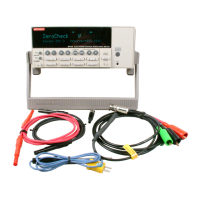IEEE-488 Reference
3-24
Program messages
A program message is made up of one or more command words sent by the computer to the in-
strument. Each common command is simply a three letter acronym preceded by an asterisk (*).
SCPI commands are categorized into subsystems and are structured as command paths. The fol-
lowing command paths are contained in the :STATus subsystem and are used to help explain
how command words are structured to formulate program messages.
:STATus Path (Root)
:OPERation Path
:PTRansition <NRf> Command and parameter
:NTRansition <NRf> Command and parameter
:ENABle <NRf> Command and parameter
:PRESet Command
1. Single command messages: There are three levels to the above command structure. The
first level is made up of the root command (:STATus) and serves as a path. The second level
is made up of another path (:OPERation) and a command (:PRESet). The third path is made
up of three commands for the :OPERation path. The four commands in this structure can
be executed by sending four separate program messages as follows:
:stat:oper:ptr <NRf>
:stat:oper:ntr <NRf>
:stat:oper:enab <NRf> :stat:pres
In each of the above program messages, the path pointer starts at the root command (:stat)
and moves down the command levels until the command is executed.
2. Multiple command messages: Multiple commands can be sent in the same program mes-
sage as long as they are separated by semicolons (;). Example showing two commands in
one program message:
:stat:pres; :stat:oper:enab <NRf>
When the above message is sent, the first command word is recognized as the root com-
mand (:stat). When the next colon is detected, the path pointer moves down to the next com-
mand level and executes the command. When the path pointer sees the colon after the
semicolon (;), it resets back to the root level and starts over.
Commands that are on the same command level can be executed without having to retype
the entire command path. Example:
:stat:oper:enab <NRf>; ptr <NRf>; ntr <NRf>
After the first command (:enab) is executed, the path pointer is at the third command level
in the structure. Since :ptr and :ntr are also on the third level, they can be typed in without
repeating the entire path name. Notice that the leading colon for :ptr and :ntr are not includ-
ed in the program message. If a colon were included, the path pointer would reset to the root
level and expect a root command. Since neither :ptr nor :ntr are root commands, an error
would occur.

